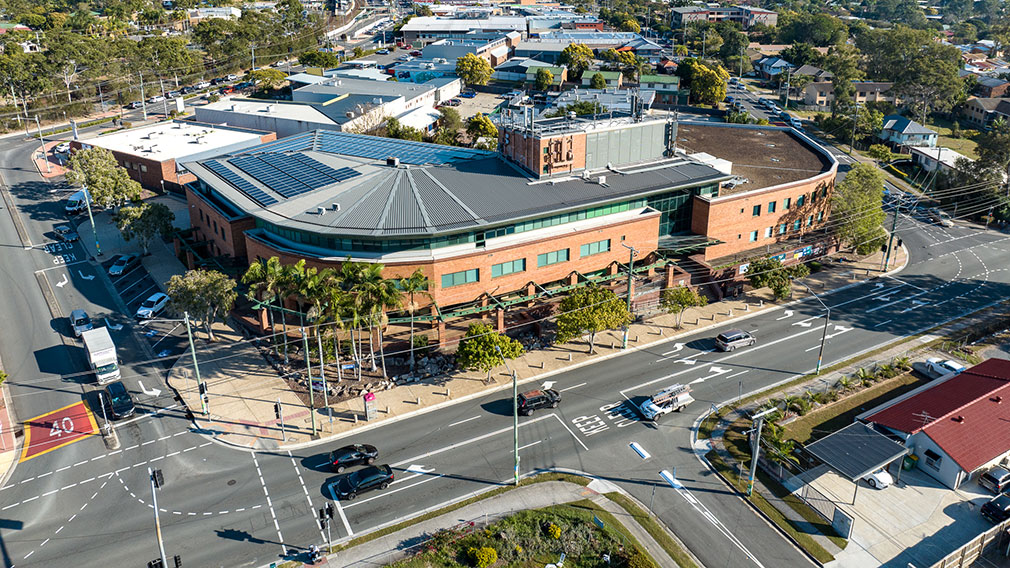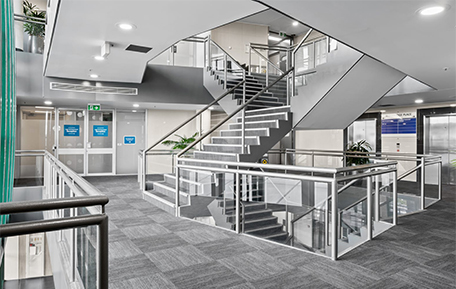Breathing new life into old office buildings

This 1980’s built office building in Logan Central was retrofitted by Patella Group to bring it into line with modern day efficiency standards. (Supplied)
Reducing the carbon footprint of Australia’s offices means not just building better, but re-fitting older premises to bring them up to date with modern energy efficiency standards.
Commercial real estate accounts for around 10 per cent of Australia’s total greenhouse gas emissions*, mainly via energy consumption, so a sector-wide effort to improve the energy efficiency of offices can have an impact in helping the country meet its climate targets.
It also makes economic sense, as Patella Group’s work demonstrates. The Queensland-based owner and developer undertook a three-year overhaul of a mid-1980’s-built office in the Brisbane suburb of Logan Central, achieving a major reduction in the building’s energy bills.
“The building went from being a very high consumption asset as far as utilities and maintenance go, with poor energy efficiency, to being even more efficient and fine-tuned than many of our new buildings in the portfolio,” says San Patella, the group’s Facilities Manager.
Patella and his team installed new lifts, put solar panels on the roof, switched from a water-cooled ventilation system to air-cooled, and brought in LED lighting throughout the building, as part of a transformation that unlocked big savings in energy and water use.
They also installed a building management system, which Patella describes as the “brain of the building” - software which helps to optimise its performance by limiting unnecessary energy use.
Among the more innovative solutions, the team deployed carbon monoxide sensors and thermostats in the underground car park to help optimise the use of exhaust fans to maintain consistent air quality.
As a result of the changes, the building’s NABERS Energy rating lifted from 0.5 stars to 5.5 stars, Patella says. The highest rating is 6 stars.
The National Australian Built Environment Rating System is the industry benchmark for measuring the sustainability of a building. Increasingly, commercial tenants are demanding a minimum level of NABERS rating as a condition of signing a lease. For example, government tenants rule out any office rated below 4.5 stars, Patella says.
“That pushes landlords to upgrade because otherwise they’re not going to get those platinum leases.”
For Patella Group, NABERS serves as a report card on a retrofit or upgrade because the rating is based on 12 months of performance data in order to give an accurate picture of operational efficiency.
“When that first 12 months of data comes through, we get very excited because we want to know how we did,” Patella says.
Learning from experience, including any mistakes, is critical to carrying out effective building upgrades, he adds.
“I don’t like to do two core upgrades too close together because I want to run one for a while to see what was good about it,” Patella says. “Sometimes you find that the ongoing maintenance cost of a change you’ve introduced can null and void your efficiency increases.”

New interiors at the Logan Central premises. (Supplied)
Patella says that Australia has generally lagged behind developed countries in the northern hemisphere in terms of improving the energy efficiency of its office buildings. He puts that down in part to Australia’s warmer climate, which means there has not been the same urgency to invest in better insulation.
In contrast, the country has been quicker to embrace technology that optimises water use, given its relative scarcity.
And Patella says the industry is now catching up in response to tenant and investor demands for more sustainable buildings.
Westpac last year announced a revised target (PDF 9MB) for reducing its financed emissions in the commercial real estate sector (office buildings) as part of its commitment as a member of the global Net-Zero Banking Alliance.
The bank is targeting a 59 per cent reduction in Scope 1 and 2 emissions intensity (kgCO2-e/m2 net lettable area) by 2030 from a 2022 baseline and is supporting its customers in the sector as they develop their emissions reduction plans, including providing finance for renewable energy or energy efficiency projects.
“Adopting a circular economy approach and revitalising ageing assets presents owners with new opportunities to unlock the value of their buildings,” says Heather Bolt, ESG Property Sector Lead in Westpac Group’s Business & Wealth Division.
“As the Patella Group has demonstrated, retrofitting existing buildings may reduce operating costs, increase tenant demand, and enhance long-term resilience,” Bolt adds.
Westpac and BankSA are also partnering with developer Kambitsis Group on the retrofit and transformation of two office buildings in Adelaide.
The project, due for completion in 2024, is aiming to be all electric and includes a high-performance façade and energy efficient air conditioning to reduce emissions and operating costs^.
As for San Patella, his motivation is simply to design better buildings – buildings that operate safely and efficiently for a quarter of a century and longer, while providing an environment that people look forward to working in.
“The end result is that what we’re doing is also good for the planet,” he adds.
NOTES
* Data from the government Dept. of Climate Change, Energy, the Environment and Water.
^ Information taken from Westpac’s 2023 Climate Report (PDF 9MB) (p34)



